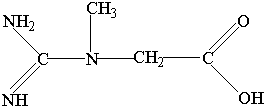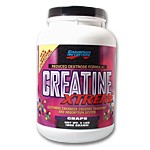Creatine

chemical structure of creatine
Creatine

chemical structure of creatine
What is Creatine?
Creatine is an amino acid, with the
chemical name methyl guanidine-acetic acid, that can be converted into
the phosphocreatine. Phosphocreatine is storage mechanism muscle
cells use to regenerate the cells primary source of energy adenosine triphosphate
(ATP). Phosphocreatine has the ability to react with adenosine diphosphate
(ADP), a byproduct of muscle contraction, and convert ADP to ATP for immediate
energy.

Were does it come from?
Creatine can be synthesized in the
liver, kidney, and pancreas from the three common amino acids Arginine,
Glycine and Methionine. This involves a reversible transfer of an
amidine group from arginine to glycine to form guanidinoacetic acid.
An irreversible transfer of a methyl group then follows up this step from
S-adenosylmethionine to the guanidinoacetic acid to form creatine.
When creatine is obtained in the diet this mechanism is suppressed.
Creatine can also be located in the diet from milk, steak and some fish.
Beef, pork, tuna, salmon, and cod all contain between 1.4 to 2.3 grams
of creatine per pound. Herring contains the most creatine at 3 to
4.5 grams per pound. Recently creatine supplementation has become
an issue as a performance enhancing product.
How can Creatine be taken?
There are many products available for
the supplementation of creatine into the body. Liquids, powders,
tablets, gel caps, effervescent tablets, and even chewing gums are being
used as a delivery mechanism of creatine. Creatine has been known
about for 160 years, and was first used as a supplement in World War I
by German scientist. It was given to German soldiers to reduce fatigue
in combat.
What happens when Creatine is ingested?
When the body uptakes creatine into the body there are
four documented effects. The first effect is the most important benefit
of the product which is the quick transformation of ADP to ATP from creatine
phosphate. This is important because in the human body there is an
expendable amount of ATP, which will be consumed in ten to fifteen
seconds of maximal exertion. Creatine can also help volumize muscle
cells. Creatine helps pull water into muscle cells increasing their
size. It is unclear if this effect has any benefits to enhance strength
but the first effect is by far the most important. Recent studies
also have shown of two more possible effects. Creatine has been show
to buffer Lactic Acid build-up and enhance protein synthesis. These
effects have not been tested enough and more research must be completed
to determine their validity.
How much Creatine?
The amount of creatine per person varies depending on
the persons weight and muscle mass. An average male weighing 160
pounds would have about 120 grams of creatine in their system. 95%-98%
of this creatine would be stored in muscles and the other 2%-5% would be
found in the brain, heart and testes. About two grams of creatinine,
the waste product of creatine, would be excreted per day and half of this
amount would be from liver synthesis. The other half would be from
that persons diet. Many producers of the creatine supplement insist
on loading with creatine for the first week. This loading dose could
be as much as 20 grams per day. It has been shown that there are
not great gains in strength, muscle mass, or indurance for those who load
compared to those who don't load. The loading phase probably is just
a scheme for the producers of the product to make more money. The
recommended dose of creatine supplement is 5 grams per day. Creatine
should be taken in cycles, meaning that it should be supplemented for a
period of time and then that person should take a break from the supplementation.
Should Creatine be banned from athletic performances?
Creatine should not and could not be
banned form athletic competitions. An athlete who consumes creatine
can only hold about five grams of creatine per kilogram of muscle and this
amount could be obtained through eating large quantities of meat and fish.
The same waste product of creatine, creatinine, would be excreted in the
urine and the competitor could not be excluded from competition.
Creatine, one of the most widely known and used products has no immediate
detrimental side effects. It has been one of the most widely analyzed
and researched natural supplement and no evidence has been found that supplementation
of this product, along with a well balance diet, is harmful. When
one supplements with creatine it is necessary to drink plenty of water
making sure not to put strain on the kidneys.
Related links
http://www.sportsci.org/traintech/creatine/rbk.html